1. Stevens RG, Blask DE, Brainard GC, Hansen J, Lockley SW, Provencio I, et al. Meeting report: the role of environmental lighting and circadian disruption in cancer and other diseases. Environ Health Perspect. 2007; 115(9):1357–1362. PMID:
17805428.
2. Fonken LK, Workman JL, Walton JC, Weil ZM, Morris JS, Haim A, et al. Light at night increases body mass by shifting the time of food intake. Proc Natl Acad Sci U S A. 2010; 107(43):18664–18669. PMID:
20937863.
3. Turner PL, Van Someren EJ, Mainster MA. The role of environmental light in sleep and health: effects of ocular aging and cataract surgery. Sleep Med Rev. 2010; 14(4):269–280. PMID:
20056462.
4. Weiss S, Schaeffel F. Diurnal growth rhythms in the chicken eye: relation to myopia development and retinal dopamine levels. J Comp Physiol A Neuroethol Sens Neural Behav Physiol. 1993; 172(3):263–270.
5. Quinn GE, Shin CH, Maguire MG, Stone RA. Myopia and ambient lighting at night. Nature. 1999; 399(6732):113–114. PMID:
10335839.
6. Saw SM, Wu HM, Hong CY, Chua WH, Chia KS, Tan D. Myopia and night lighting in children in Singapore. Br J Ophthalmol. 2001; 85(5):527–528. PMID:
11316706.
7. Grisham JD, Sheppard MM, Tran WU. Visual symptoms and reading performance. Optom Vis Sci. 1993; 70(5):384–391. PMID:
8515967.
8. Cohen Y, Segal O, Barkana Y, Lederman R, Zadok D, Pras E, et al. Correlation between asthenopic symptoms and different measurements of convergence and reading comprehension and saccadic fixation eye movements. Optometry. 2010; 81(1):28–34. PMID:
20004875.
9. Agnew HW Jr, Webb WB, Williams RL. The first night effect: an EEG study of sleep. Psychophysiology. 1966; 2(3):263–266. PMID:
5903579.
10. Schulze MM, Jones DA, Simpson TL. The development of validated bulbar redness grading scales. Optom Vis Sci. 2007; 84(10):976–983. PMID:
18049363.
11. Ames SL, Wolffsohn JS, McBrien NA. The development of a symptom questionnaire for assessing virtual reality viewing using a head-mounted display. Optom Vis Sci. 2005; 82(3):168–176. PMID:
15767873.
12. Suh YW, Kim KH, Kang SY, Kim SW, Oh JR, Kim HM, et al. The objective methods to evaluate ocular fatigue associated with computer work. J Korean Ophthalmol Soc. 2010; 51(10):1327–1332.
13. Hannibal J, Fahrenkrug J. Neuronal input pathways to the brain's biological clock and their functional significance. Adv Anat Embryol Cell Biol. 2006; 182:1–71. PMID:
16566431.
14. Gachon F, Nagoshi E, Brown SA, Ripperger J, Schibler U. The mammalian circadian timing system: from gene expression to physiology. Chromosoma. 2004; 113(3):103–112. PMID:
15338234.
15. Czeisler CA, Klerman EB. Circadian and sleep-dependent regulation of hormone release in humans. Recent Prog Horm Res. 1999; 54:97–130. PMID:
10548874.
16. Pandi-Perumal SR, Srinivasan V, Maestroni GJ, Cardinali DP, Poeggeler B, Hardeland R. Melatonin: nature's most versatile biological signal? FEBS J. 2006; 273(13):2813–2838. PMID:
16817850.
17. Skene DJ, Lockley SW, Thapan K, Arendt J. Effects of light on human circadian rhythms. Reprod Nutr Dev. 1999; 39(3):295–304. PMID:
10420432.
18. Schernhammer ES, Hankinson SE. Urinary melatonin levels and breast cancer risk. J Natl Cancer Inst. 2005; 97(14):1084–1087. PMID:
16030307.
19. Figueiro MG, Rea MS, Bullough JD. Does architectural lighting contribute to breast cancer? J Carcinog. 2006; 5(1):20. PMID:
16901343.
20. Erren TC, Pape HG, Reiter RJ, Piekarski C. Chronodisruption and cancer. Naturwissenschaften. 2008; 95(5):367–382. PMID:
18196215.
21. Knutsson A. Health disorders of shift workers. Occup Med (Lond). 2003; 53(2):103–108. PMID:
12637594.
22. Liu JH, Kripke DF, Twa MD, Hoffman RE, Mansberger SL, Rex KM, et al. Twenty-four-hour pattern of intraocular pressure in the aging population. Invest Ophthalmol Vis Sci. 1999; 40(12):2912–2917. PMID:
10549652.
23. Liu JH, Zhang X, Kripke DF, Weinreb RN. Twenty-four-hour intraocular pressure pattern associated with early glaucomatous changes. Invest Ophthalmol Vis Sci. 2003; 44(4):1586–1590. PMID:
12657596.
24. Tan CS, Ouyang Y, Ruiz H, Sadda SR. Diurnal variation of choroidal thickness in normal, healthy subjects measured by spectral domain optical coherence tomography. Invest Ophthalmol Vis Sci. 2012; 53(1):261–266. PMID:
22167095.
25. Chakraborty R, Read SA, Collins MJ. Diurnal variations in axial length, choroidal thickness, intraocular pressure, and ocular biometrics. Invest Ophthalmol Vis Sci. 2011; 52(8):5121–5129. PMID:
21571673.
26. Nickla DL. Ocular diurnal rhythms and eye growth regulation: where we are 50 years after Lauber. Exp Eye Res. 2013; 114:25–34. PMID:
23298452.
27. Stone RA, Pardue MT, Iuvone PM, Khurana TS. Pharmacology of myopia and potential role for intrinsic retinal circadian rhythms. Exp Eye Res. 2013; 114:35–47. PMID:
23313151.
28. Cohen Y, Peleg E, Belkin M, Polat U, Solomon AS. Ambient illuminance, retinal dopamine release and refractive development in chicks. Exp Eye Res. 2012; 103:33–40. PMID:
22960317.
29. Himebaugh NL, Begley CG, Bradley A, Wilkinson JA. Blinking and tear break-up during four visual tasks. Optom Vis Sci. 2009; 86(2):E106–E114. PMID:
19156014.
30. Cardona G, García C, Serés C, Vilaseca M, Gispets J. Blink rate, blink amplitude, and tear film integrity during dynamic visual display terminal tasks. Curr Eye Res. 2011; 36(3):190–197. PMID:
21275516.
31. Kim DJ, Lim CY, Gu N, Park CY. Visual fatigue induced by viewing a tablet computer with a high-resolution display. Korean J Ophthalmol. 2017; 31(5):388–393. PMID:
28914003.
32. Ousler GW 3rd, Hagberg KW, Schindelar M, Welch D, Abelson MB. The ocular protection index. Cornea. 2008; 27(5):509–513. PMID:
18520496.
33. Toda I, Fujishima H, Tsubota K. Ocular fatigue is the major symptom of dry eye. Acta Ophthalmol (Copenh). 1993; 71(3):347–352. PMID:
8362634.
34. Kang BS, Seo MW, Yang HK, Seo JM, Lee S, Hwang JM. Comparison of blinking patterns when watching ultra-high definition television: normal versus dry eyes. J Korean Ophthalmol Soc. 2017; 58(6):706–711.
35. Cho JR, Joo EY, Koo DL, Hong SB. Let there be no light: the effect of bedside light on sleep quality and background electroencephalographic rhythms. Sleep Med. 2013; 14(12):1422–1425. PMID:
24210607.
36. Cho CH, Lee HJ, Yoon HK, Kang SG, Bok KN, Jung KY, et al. Exposure to dim artificial light at night increases REM sleep and awakenings in humans. Chronobiol Int. 2016; 33(1):117–123. PMID:
26654880.
37. Thomas KS, Motivala S, Olmstead R, Irwin MR. Sleep depth and fatigue: role of cellular inflammatory activation. Brain Behav Immun. 2011; 25(1):53–58. PMID:
20656013.
38. Lee YB, Koh JW, Hyon JY, Wee WR, Kim JJ, Shin YJ. Sleep deprivation reduces tear secretion and impairs the tear film. Invest Ophthalmol Vis Sci. 2014; 55(6):3525–3531. PMID:
24833736.
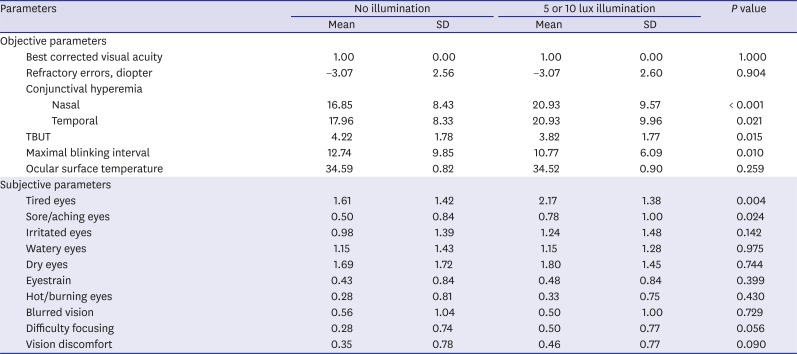
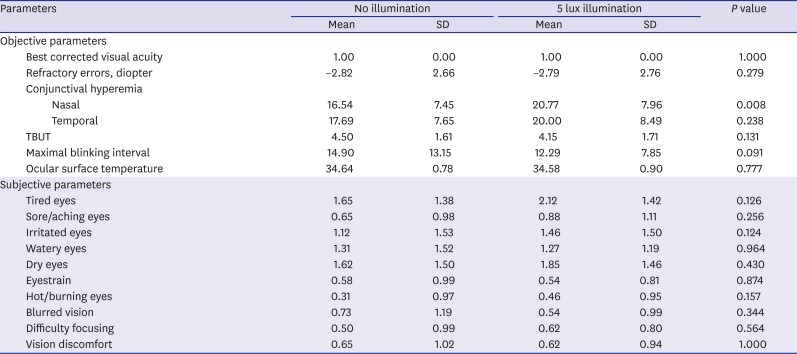
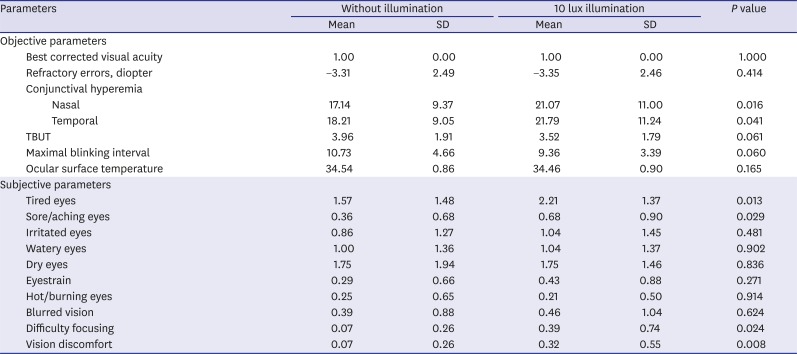
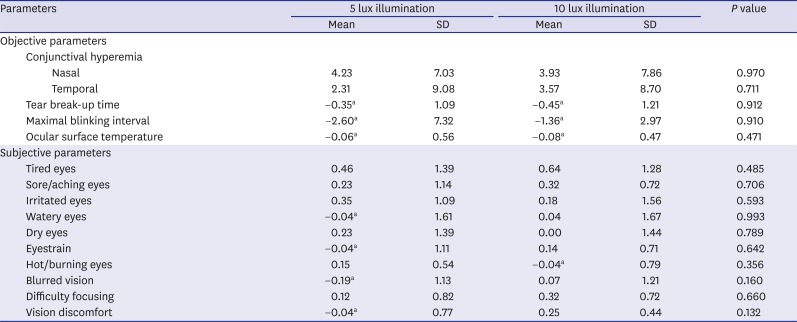




 PDF
PDF Citation
Citation Print
Print



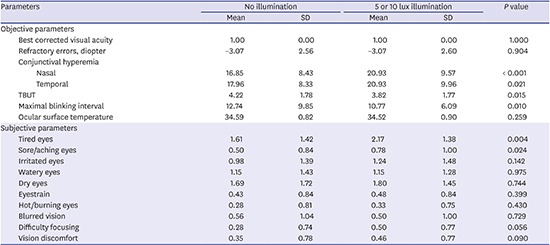
 XML Download
XML Download